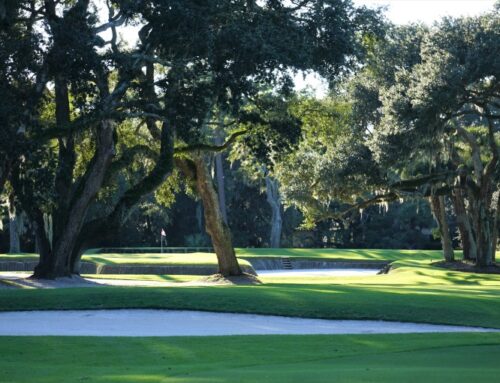Fishers Island Club
NY, USA
Green Keeper: Donald Beck
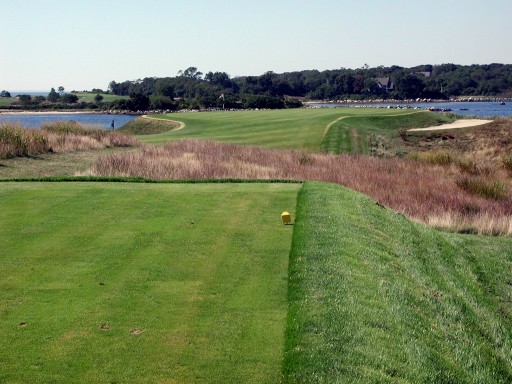
Classic architecture in a stunning setting – the Eden hole at Fishers Island.
Comparing courses keeps an idle mind out of trouble and in the case of comparing Cypress Point and Fishers Island, it can actually be instructive in terms of appreciating certain qualities that each course possesses. Though distinctly different, both coursescan lay claim to being the most enchanting place on their respective coasts for a game. The property at the Cypress Point Club is more diverse as it features woodland, dunes and coastal portions. Conversely, Fishers Island features many more holes along the coast with water in view from all but a few holes. The soil is sandy at Cypress and Alister MacKenzie built many of his green complexes to meld into their surrounds. Fishers Island has more abrupt topography and Seth Raynor routedtwelve holes to touch its rocky shoreline. As was his want, Seth Raynor pushed up many of the greens, and in this case he created numerous plateau greens. The green complexes are more fortified in appearance at Fishers Island than at Cypress. Fishers Island doesn’t have the artistry of Cypress Point; Seth Raynor‘s style is more manufactured and engineeredthan MacKenzie’s. The fact that Seth Raynor got the rocky site and MacKenzieinherited thesandy one is just fine with the author. In many respects, Seth Raynor‘s pushed up greens on such holes as the 3rd, 7th, and 11th only add drama to their alreadyexcitinglocations. There are two othertelling factors with these elevated green pads. Firstly,the back drop to the flag stick is often well in the distance, as in mainland Connecticut! The 3rd, 6th, 7th, 9th, 10th, and 11th holes have nothing around the green to assist the golfer in gauging the distance for his approach shot. This featureis more dominate at Fishers Island than any other course in the United States. Many of Fishers Island members come from the Winged Foot type clubs in New York and Connecticut were trees frame every hole. There is no such (mis)fortune at Fishers Island (side note: thetrouble past numerous greens (the 3rd, 4th, 7th, 9th, 11th, 13th, and 18th ) is often worse than that in front of the green). Secondly, running shots in low under the wind is tricky to some of these green pads. Some fairways feeddirectly onto the greens such as at the 1st, 8th, 13th and 14th holes and a running shot is fairly straightforward. The going gets tougher with the more pronounced green pads such as at the 3rd, 7th and 11th holes but Seth Raynor always provides a way onto the green, provided the golfer is coming in from theproper angle. Green Keeper Don Beck does a superb job of maintaining the fairways in a fast and firm manner and seeing a ball bounding along the ground at Fishers Island is one of the game’s great joys.
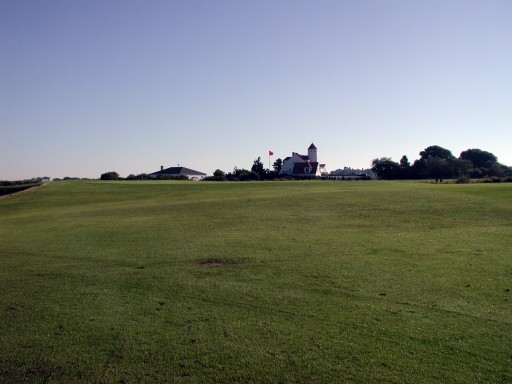
The 1st green accepts a running ball though the ground contours tend to push …

…the ball into the left greenside bunker. The bunker is well below the putting surface and the total absence of framing of the green is most attractive.
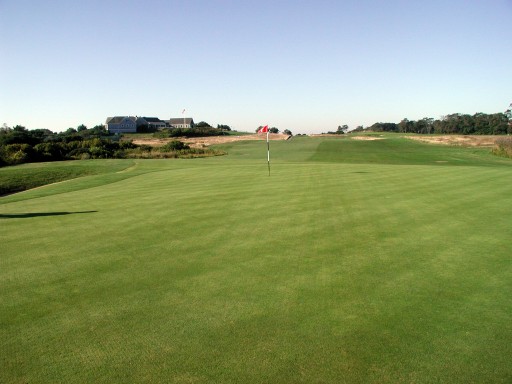
The downhill nature of the 1st hole is evident from behind the green. Raynor wisely left the green open in front as the hole is frequently downwind.
Needless to say, its location on an island in Long Island Sound ensures that the wind is never far away and it blows from all directions. An example of its effect was highlighted during a three day, four round stay at Fishers Island one fall. The author hada 4, 6, 7, and 2 iron into the 165 yard 11th hole. The green complex, as with the rest of the course, was built to handle these changing weather conditions. This diversity makes Fishers Island a delight and courses without wind pale in comparison. Holes to Note 2nd hole,170 yards; The classic set of Seth Raynor one shotters are found at Fishers Island, with the first one being a Redan with the green angled away at 45 degrees and the usual slope from the back right. This hole can be a rude awakening to golfers not accustomed to the effect of the wind as apond in front of this Redan gobbles up a ballooned tee ball.
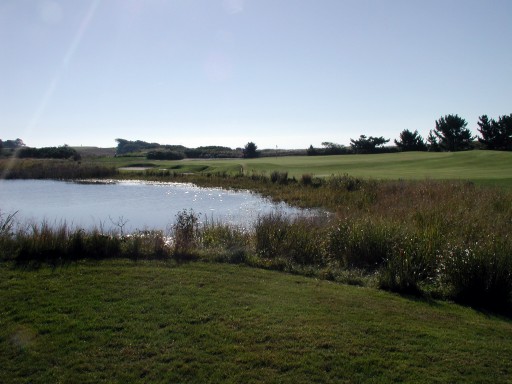
The right to left tilt of the green is evident above and the golfer is best served in using it to chase after the back left hole locations where the pond nears the green.
3rd hole,335 yards; The merit of this short two shotter lies in the difficulty of judging the approach shot to this horizon green, which is quite big and none too difficult to putt for a hole of this length. The difficulty in throwing a wedge shot well onto the green stems from 1. the severity of the deep bunkers that wrap around the side and back of the green, 2. the flag flaps against only the horizon, making distance difficult to judge, and 3. the built up green is fully exposed to the elements as it is perched on the bluff. As read in the excellent club history book entitled Sixty-Seven Years of The Fishers Island Club Golf Links, author Charlie Ferguson quotes Grantland Rice as considering this ‘the most difficult easy hole that I ever played.’

The uphill approach at the 3rd seems simple enough. However, closer inspection reveals…
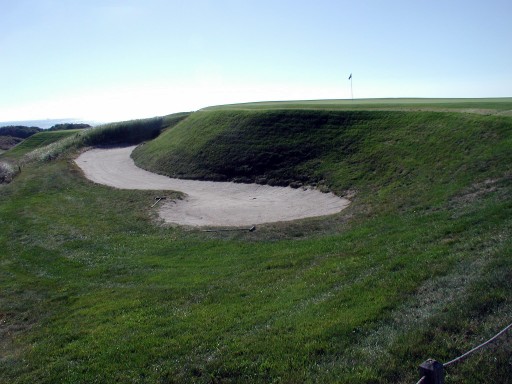
…that the green is indeed a good one to hit as neither the left greenside bunker…
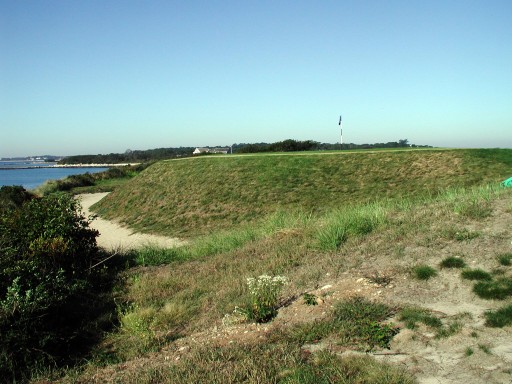
…nor the back one is an easy one from which to recovery.
4th hole,400 yards; Seth Raynor‘s rendition of an ‘Alps’ and ‘Punchbowl’ provides the only blind approach shoton the course. Along with the 10th hole, the 4th has no bunkers and yet these holes are the stoutest two shotterson the course.
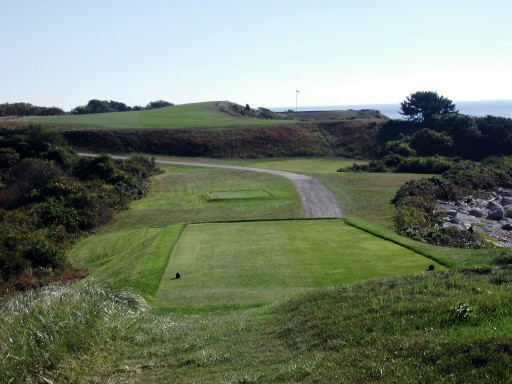
After (hopefully!) reaching the fairway, the golfer hits a blind approach toward the directional marker that stands behind hidden green.
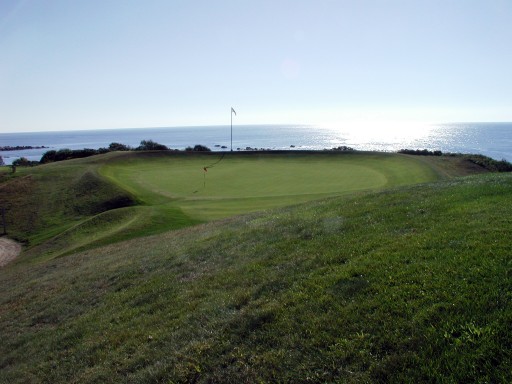
The enormous punchbowl green complex that juts into the sound helps make the 4th a one of a kind hole in the world of golf.
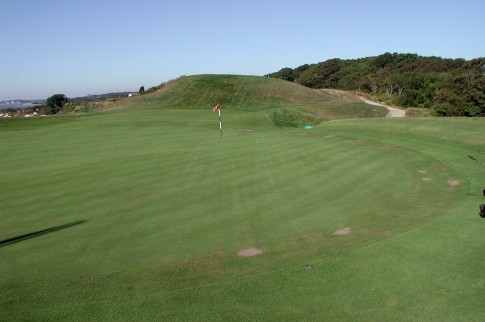
Looking from behind the 4th green at the hill that one’s approach must carry – not many architects would have the courage to build the same hole today, which is a pity as many consider it the most exciting one on the course.
5th hole,225 yards; Fisher’s Biarritz does a wonderful job of capturing the fear that one senses from Dunn’s design at the Biarritz Golf Clubin France as the golfer plays from an elevated tee to a green in the far distance with nothing in between but wilderness.Though the Biarritz green is not full length and starts after the swale, the author still believes this long one shotter should be included in the same grouping asthe 16th at Cypress Point, Seth Raynor’s 9th at Yale, and the 13th at The Addington as among the finest in the world.

Raynor was a master at creating long one shotters full of playing interest. The swale just prior to the putting surface is evident above.
7th hole, 380 yards;Though not the finest or toughest hole on the course,the 7th still encapsulates the virtues of a game at Fishers Island as well as any on the course as it is both visually striking and full of strategic merit.
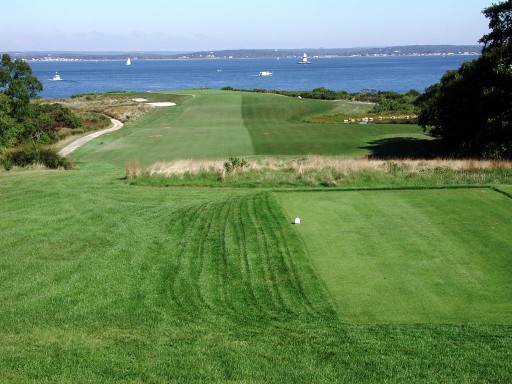
The view from the 7th tee is so inspiring that few golfers ever notice how well designed the hole is: the closer one drives to a water hazard long right down the fairway…
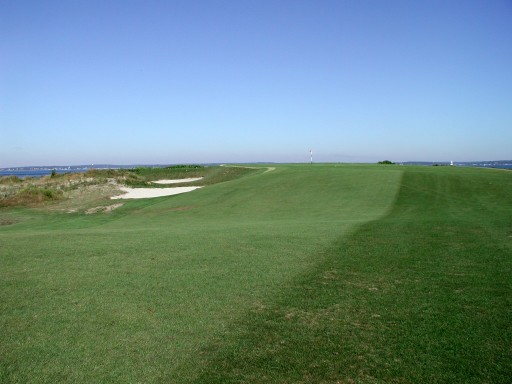
…the better the angle into the front right to back left angled green.
8th hole, 470 yards; As at the last hole, the closer one drives to the trouble (i.e the shoreline down the right), the better angle of play one has intothe angled green. This half par hole was voted by GOLF Magazine in the 1980s as among the very best in the country.Raynor and his playing angles had a tremendous impact ona young golfer named Pete Dye.For instance,a hole like the 8th favors a fade on the tee ball and a draw on the approach. Pete Dye repeats this ‘switch back’ design on numerous holes throughout his design career.
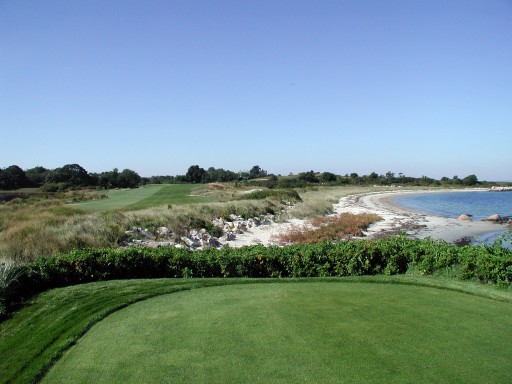
The ideal tee ball is down the right.
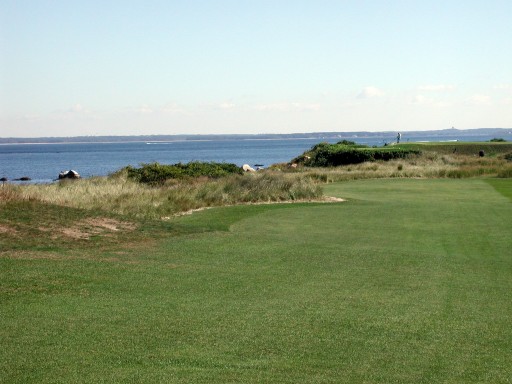
Looking back down the 8th fairway at the tee – though the tee complex is built up, it still looks apart of its surrounds.
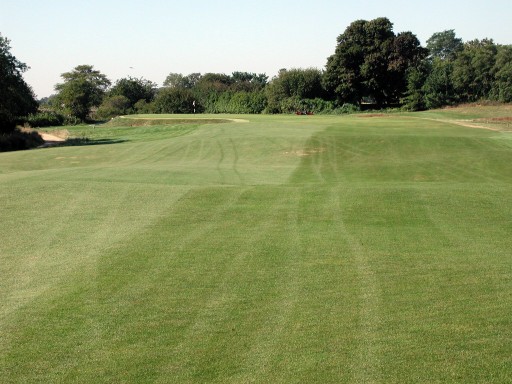
The 8th green is best approached from the right (the darker green) portion of the fairway.
9th hole, 365 yards; Raynor’s Double Plateaugreenjoins the Home green as being the mostsevere on the course. How close is the green to Fishers Island Sound? Raynor’s back bunker has been abandoned due to erosion by storm waves.
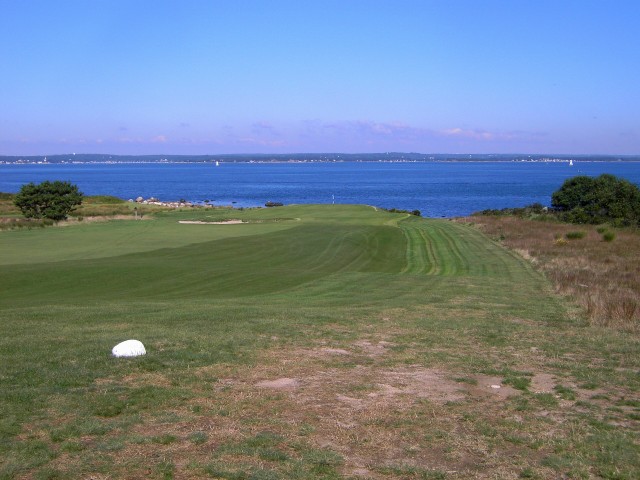
For many, the approach to the 9th is the most thrilling shot on the course. The fronting left bunker makes staying on the front plateau problematic.
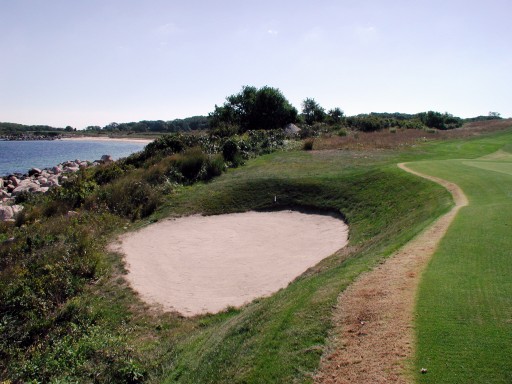
A front left bunker at the 9th green is clearly visible on one’s approach and makes many a golfer inadvertently go into this hidden back right bunker. The green surrounds help funnel a ball into the bunker.
10th hole, 400 yards; Fishers is famous for its lack of fairway bunkers but such a fact is a sure indication of plenty of topography.
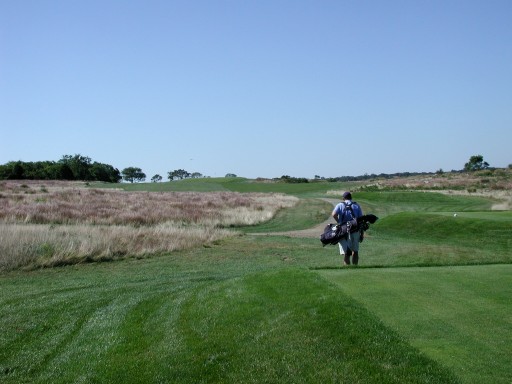
The golfer heads off the 10th tee. The green is the high point in the distance.
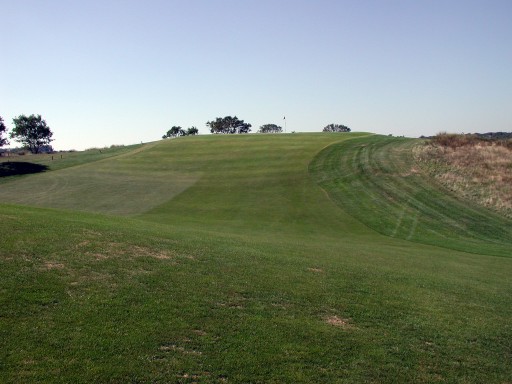
The plateau 10th green is a tough one to hit and hold, especially when the wind is up. Even here, Raynor built it up a few extra feet from its surrounds.
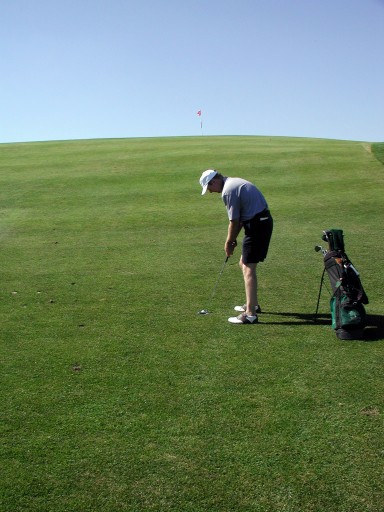
The ball that comes up fractionally short of the 10th is likely to roll quite a bit back, thanks to the great topography as well as Green Keeper Don Beck’s adherence to fast and firm.
11th hole,165 yards; The green is on an exposed knob and is an outstandingtribute to the ‘Eden’ at St. Andrews. ‘Steam Shovel’ Banks form is evident with thetwelve foot deep bunker that wraps around the left side of this green. Crucially, one of the key terrors of the original Eden hole is the fear of going over the green and that fear is perfectly replicated with this horizon green.Certainly Raynor/Macdonald’s finest Eden, and the finest in the U.S. as well,with only the home hole at Garden City Golf Club as a possible rival.
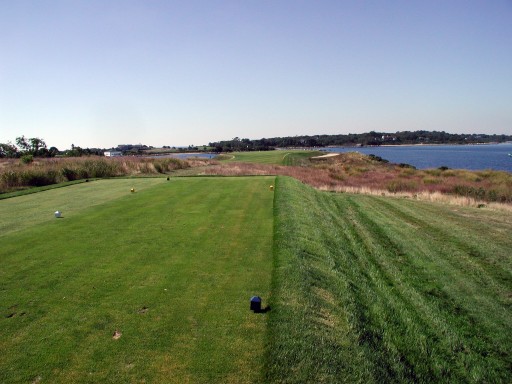
Raynor’s superb routing showcases the finest attributes of the eastern part of the island.
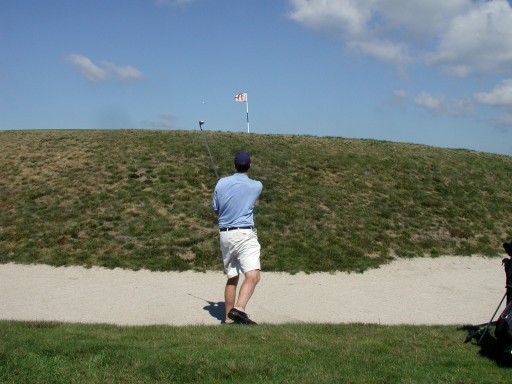
The right, or Strath bunker, is the shallower of the two greenside bunkers.
12th hole, 390 yards; The essence of good golf design is to give the golfer something to do. The more fearsome the hazard, the more rewarding a sense of accomplishment. However, too many modern architects ruined this simple principle by building every hazard hard while failing to give the golfer any way around them. At the 12th, Raynor’s fronting bunker is indeed frighteningly deep butRaynor in turn banked the entire back of the green to push balls toward the middle and right hole locations.
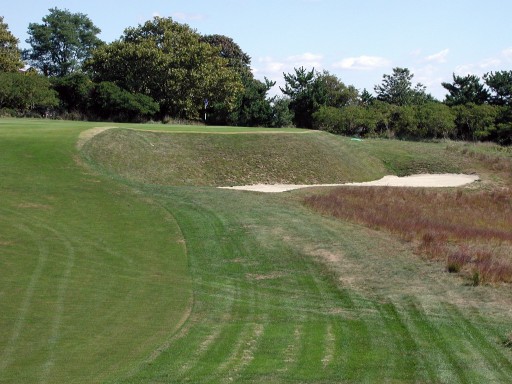
The menacingly deep bunker that fronts the Reverse Redan green can be avoided…
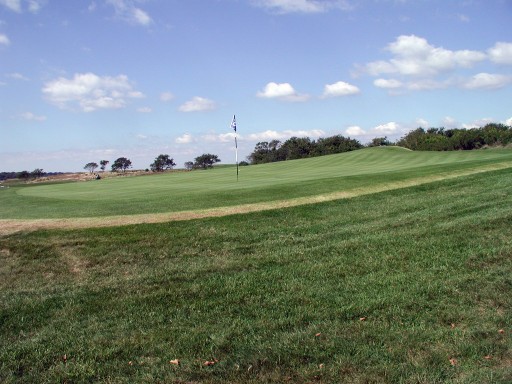
…by using the kickboard that Raynor provided at the back of the green for working the ball right and across the 12th green.
13th hole,400 yards; The golfer has just played as attractive a stretch of green complexesas one can imagine but even the 10th green is raised above the natural grade. Raynor shifts gears here with lower profile greens at the 13th and 14th, reflective of the fact that the property has flattened out a bit.
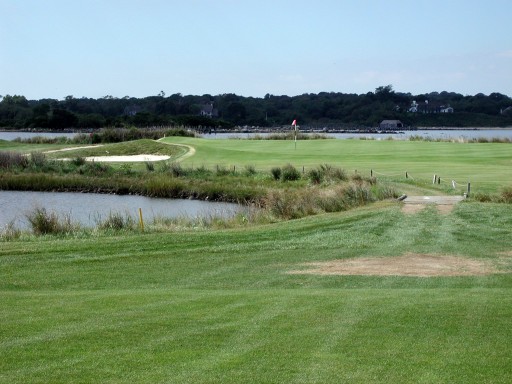
The 13th green is lower profile than most on the course, allowing for a handsome view behind.
16th hole, 145 yards; One of Raynor’s most scenic Short holes, it nonetheless needs the wind to stiffen the challenge as the green is not as fiercely defended ala his Short holes at Lookout Mountain and Camargo. In addition, though good, the interior green contoursare not in the same leagueas the Short at Chicago Golf Club or Saint Louis Country Club.
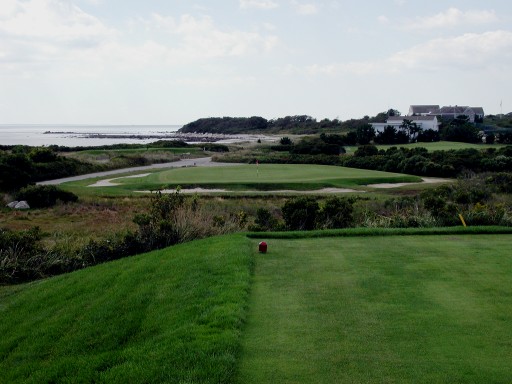
The Short at Fishers.
18th hole, 475 yards; A thrilling Home hole that replicates the playing angles of the Road hole at The Old Course at St. Andrews, the length of this hole makes it a great half par hole for deciding the match. Instead of railroad sheds, the golfer plays over a finger of East Harbor and further the carry he is willing to take, the better the angle into the elevated green with its dominate left central ‘Road’ bunker along this kidney shaped green.
If the 15th through the 17th offered just slightly more compelling shots, Fishers Island certainly would beamong the author’s dozen favorite courses in the world. Regardless, Fishers Island is blessed withthe key ingredients of an awe inspiringsetting, a superb routing along the edge of an island, and a classic set of holes.
Importantly, another major attribute that it enjoys over almost every course of significance in the United States is that it lacks a fairway irrigation system. Green Keeper Don Beck and his crew do a superb job of keeping the grass barely alive during the summer and the resulting firm playing conditions are ideal for golf. The author is reminded of Bill Coore’s conversation with an Australian Green Keeper, who told him,’The problem with you Americans is that you concentrate on growing grass. Here in Australia, we focus on keeping it from growing.’ Just as the golfer delights in seeing his ball bounce all over the place when Royal Melbourne West’s fairways arebaked in the summer, the same applies here at Fishers. All in all,there are precious few spots a golfer would rather find himself.

The exceptional ground speed that Green Keeper Beck achieves helps to ensure that Fishers plays the way that Raynor intended, with the ball bouncing all over the rolling topography.
As the crow flies, the course is close to Shinnecock Hills on Long Island. Coupled with Maidstone, Friar’s Head and National Golf Links of America, thesefive coursessurely comprise thefinest cluster of courses in a forty mile radius. Fishers is neither the longest nor hardest of thefivebut it does enjoy the most romantic setting and is as delightful to play as any. No higher praise in the golf world is possible.
The End




![The Park, West Palm (Lit 9) [2023]](https://golfclubatlas.com/wp-content/uploads/2024/12/IMG_7092-2-scaled-500x383.jpg)



